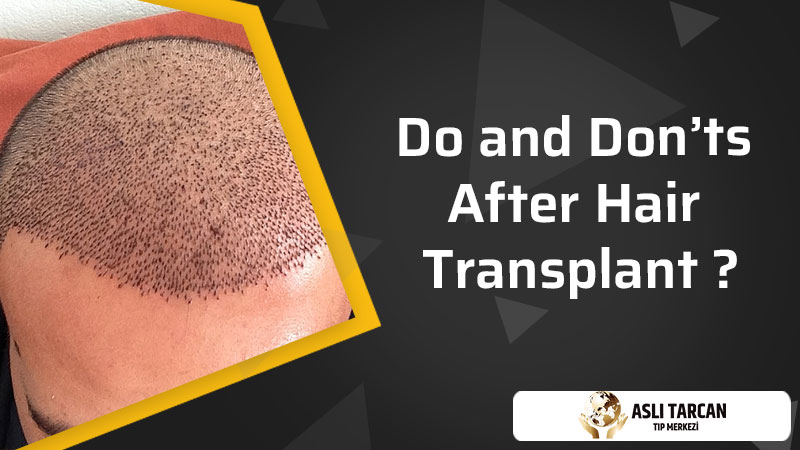Do and don’ts after hair transplant determine the longevity of the hair. Hair grafting is a surgery with a very high success rate and is made with the patient’s own living hair cells. While it can live a lifetime, some common mistakes prevent it. Common mistakes in the first 48 hours after hair transplantation:
- Combing, washing or dyeing the hair,
- Do use painkillers and antibiotics,
- Scratching or touching the scalp,
- Ignoring swelling, itching or redness,
- Sweating, exercising,
- Driving a vehicle right after hair transplant,
- Having sex, drinking water, nourishing well,
- Being exposed to thermal effects such as hat, helmet, sun, rain or spa.
It is very important for hair cells to keep clean and heal in the first 48 hours after hair transplant surgery. During this time, the hair graft and donor area are extremely sensitive. Surgeons who operate hair transplants for many years share common mistakes. As a result of these mistakes, the success rate is gradually decreasing. Since the viable cells are at the top after the surgery, its durability is low. Therefore, any physical effect results in hair cell death.
Hair restoration surgeons explain the patients do and don’ts after hair transplant. Thus, all recommendations for getting the best hair restoration result are found. Often patients forget the list easily or simply do what they think might be good. All these are harmful for the hair follicles that have not yet healed. The best hair restoration is achieved with the cooperation of the patient and the doctor. Listen to the recommendations for the hair transplant area, especially after hair restoration.
Hygiene Do and Don’ts after Hair Transplant
Hygiene do and don’ts after hair transplant are general post-operation healing rules. As in all kind of operations, an open wound is an area that is susceptible to infection. Infection of the surgical area creates conditions such as swelling, infection, and hair transplant surgery. For this reason, physicians are very confident about their surgery and themselves, but they are uneasy after the surgery.
Human skin has 3 basic layers and only the upper layer heals in the first week after surgery. In fact, full recovery takes place in two months, but the patient does not feel this period. The same is true for hair transplant treatment, and the first week is important for infection and 1 month for full recovery. First month do and don’ts after hair transplant:
- Take care of your personal care
- Use a brush to comb your hair with stiff combs
- Take a bath as often as your doctor recommends.
- Use the shampoo recommended by the doctor.
- Don’t postpone doctor check-ups
- Take vitamins and supplements
We touch everything with our hands without realizing it, most of all, when we don’t think about it. Especially if our head itches, our hand always goes there without realizing. For this reason, by not washing our hands regularly, we actually take precautions against all skin bacteria. There are some conditions that affect the success of hair transplant in baldness. Some patients inadvertently interfere with the hair restoration area by scratching, combing or palpating during the post-treatment period. In such cases, the restoration area is adversely affected, although not always.
Correcting Hair Transplant Due To Faulty Behavior
Patients who did not follow do and don’ts after hair transplant will need corrective operations. Application of the wrong behavior in hair transplantation techniques may cause an aesthetically asymmetrical appearance. In such cases, it is essential to correct the errors with hair restoration. Disproportionate spaces between hair cells are repaired by individual hair transplantation. Not following after hair transplant rules results in correction surgeries.
FUE or DHI options are the best hair restoration method for correcting faulty hair transplantation. The best hair restoration methods for recovery are FUE and DHI methods, which allow single cell hair transplantation to correct the structure that disrupts the aesthetic appearance. Especially cell deaths due to combing or other kind of physical damages need fixing. Not following “do and don’ts after hair transplant” result in errors in appearance.
Errors due to poor follow-up of the development of hair follicles and the lack of control affect the hair restoration result. Although hair transplant correction does not pose a risk to health, it causes visual discomfort for the patient.
After Hair Transplant Follow-Ups
Common care between dos and don’ts after hair transplantation are also important. It is not enough to wait for new hair to grow in order to follow the success after hair restoration. There are many issues to be in the long term after hair grafting. If you had hair transplant surgery, there is definitely something wrong with you hair and your body. If there is something wrong with your lifestyle, now is the time to get treatment. The way you nourish your body, the healthier your hair is. So,
- Review your lifestyle,
- Regulate eating habits,
- Check your vitamin and hormone levels,
- Consider changing your hair dye,
- Use natural hair care products,
- Have heathy diet!
Dos and don’ts after hair transplant are very important for you. Do not be afraid of the changes you will notice after the restoration. Your hair will fall out after the surgery, no need to panic. Since, new ones and stronger ones will grow. Do not repeat the mistakes you made before the surgery. Because obviously you’re doing something wrong, try to find your mistakes. Review your comb; learn to comb your hair correctly. Have healthy eating habits for your new hair to be strong. Stay away from stress because stress causes hair loss. Stay away from shampoos, conditioners, styling materials and devices that contain harmful chemicals. Find out if there are any diseases that cause hair loss. It would be wise to take precautions like this to avoid having hair transplant surgery again. Hair restoration is a second chance for you. Since hair loss is a sign that you are doing something wrong in your life. Make a habit of do’s and don’ts to eliminate the cause of hair loss. Celebrate your new look after hair transplant and get a new, healthier lifestyle!
African American Hair Transplant Before After Comparison
The results of African American hair transplant before after comparison reveal a remarkable transformation. A successful African American hair transplant procedure can have a positive impact on an individual’s confidence and overall well-being. By seeing how effective their transplant was, many patients are encouraged to take greater ownership of their appearance and overall health. They may feel more comfortable with trying new styles or activities that they might not have previously considered due to insecurity about their hair loss. Additionally, many patients report feeling more attractive and confident after undergoing a hair transplant procedure as they feel more like “themselves” again.

With improved self-confidence comes higher levels of satisfaction in life and better mental health in general, all benefits that can be seen through an African American hair transplant before after comparison. Overall, the results of an African American hair transplant surgery can be extremely satisfying for individuals who have experienced hair loss due to various causes such as hereditary balding or medical conditions. Following closely recommended instructions for post-operative care and follow-up visits can help ensure that the desired results last for many years, even decades into the future.



